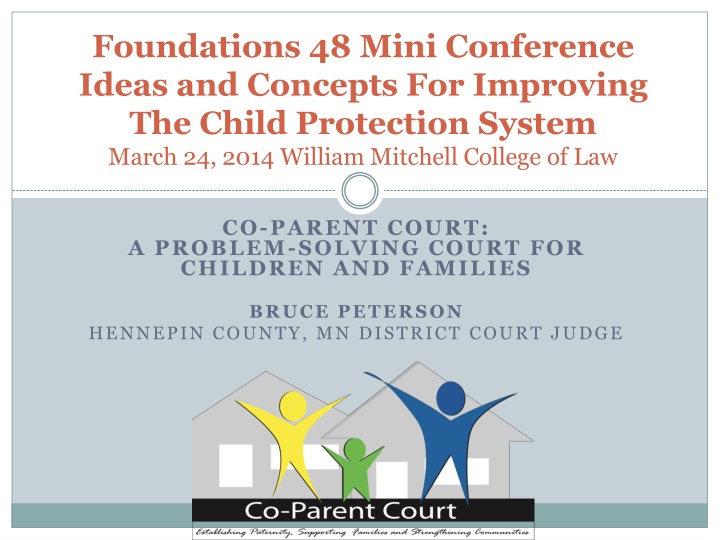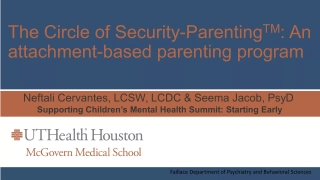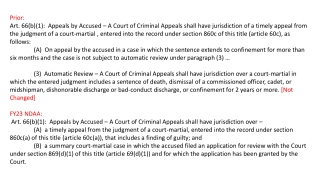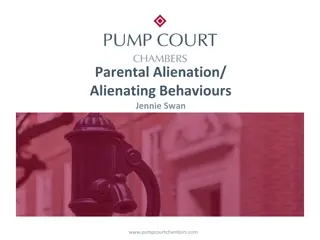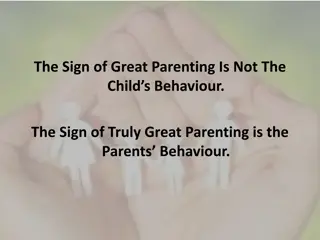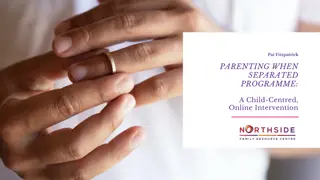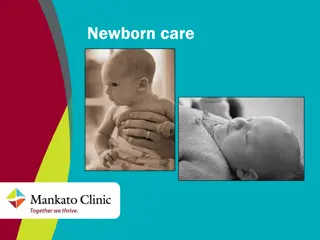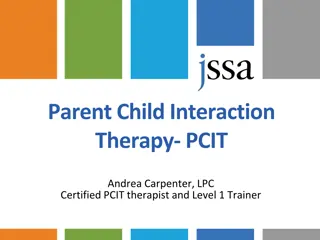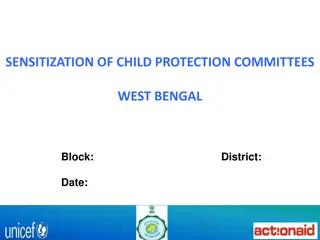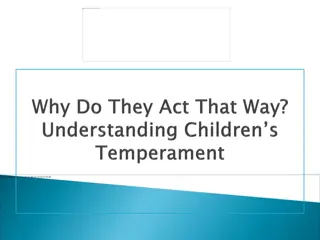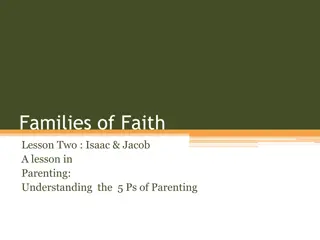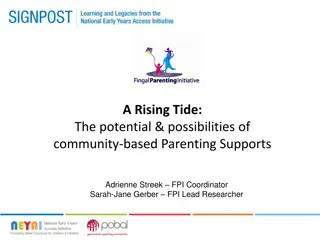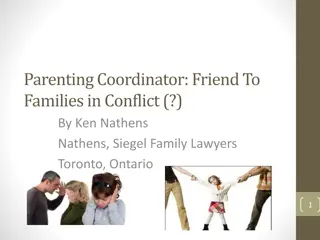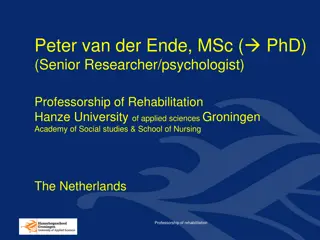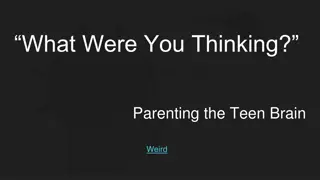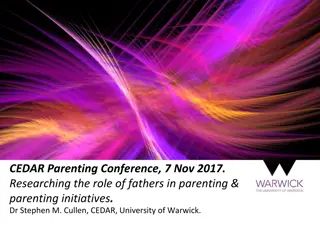Co-Parent Court: Enhancing Child Protection Through Collaborative Parenting
Explore the concept of Co-Parent Court, a problem-solving approach to family dynamics that benefits children by establishing consistent rules, promoting parental support, and fostering non-resident fathers' involvement. Dive into the impact of Adverse Childhood Experiences (ACEs) on children's well-being and the risks associated with increased ACEs, such as alcoholism, mental health issues, and risky behaviors. Understand the correlation between parental status and children's outcomes like school dropout rates and teenage pregnancies.
Download Presentation

Please find below an Image/Link to download the presentation.
The content on the website is provided AS IS for your information and personal use only. It may not be sold, licensed, or shared on other websites without obtaining consent from the author.If you encounter any issues during the download, it is possible that the publisher has removed the file from their server.
You are allowed to download the files provided on this website for personal or commercial use, subject to the condition that they are used lawfully. All files are the property of their respective owners.
The content on the website is provided AS IS for your information and personal use only. It may not be sold, licensed, or shared on other websites without obtaining consent from the author.
E N D
Presentation Transcript
Foundations 48 Mini Conference Ideas and Concepts For Improving The Child Protection System March 24, 2014 William Mitchell College of Law CO-PARENT COURT: A PROBLEM-SOLVING COURT FOR CHILDREN AND FAMILIES BRUCE PETERSON HENNEPIN COUNTY, MN DISTRICT COURT JUDGE
Why is Co-Parenting Beneficial? Parents agree on the rules and support each other s decisions Children learn parental authority is not arbitrary Children are not subjected to inconsistent discipline xviii
Why is Co-Parenting Beneficial? Children internalize social norms and moral values Children observe the modeling of interpersonal skills like communication, respect, and compromise Co-Parenting fosters non-resident fathers involvement xviii
ACEs-Adverse Childhood Experiences 1. Emotional Abuse 2. Physical Abuse 3. Sexual Abuse 4. Emotional Neglect 5. Physical Neglect xxv
ACEs-Adverse Childhood Experiences 1. Mother Treated Violently 2. Household Substance Abuse 3. Household Mental Illness 4. Parental Separation or Divorce 5. Incarcerated Household Member xxv
Increased ACEs Increased Risk Alcoholism and alcohol abuse Chronic obstructive pulmonary disease (COPD) Depression Fetal death Risk for intimate partner violence Multiple Sexual partners Sexually transmitted diseases (STDs) Smoking xxv
Increased ACEs Increased Risk Health-related quality of life Illicit drug use Ischemic heart disease (IHD) Liver disease Suicide attempts Unintended pregnancies Early initiation of smoking Early initiation of sexual activity Adolescent pregnancy xxv
Risks to Children: Quitting School and Teenage Pregnancy Parents Percentage of Children Who Drop out of High School by Parent Status Percentage of Daughters Experiencing Teenage Pregnancy by Parent Status 11% 33% 37% Married Parents Divorced Parents Never Married Parents 13% 31% 37% xiv
Children Born to Unmarried Parents in 2012 45 40 35 30 Hennepin County 25 Ramsey County Minnesota 20 Nationwide 15 10 5 0 Births to Unmarried Parents i
The percentage of children born to unmarried parents varies significantly for certain groups iii
Relationship Stability: Unmarried Parent Contact as a Function of a Child s Age Child s Age Married Cohabiting Romantically Involved Friends No Contact Birth 0% 50% 32% 8% 10% Age 5 17% 19% 3% 20% 42% xiv
Child Connection: Contact With Children by Non-Resident Fathers Regular Contact Limited Contact No Contact by Father Age 1 62% 26% 13% Age 3 47% 24% 29% Age 5 43% 20% 37% xvii
Research Establishes Four Realities Children who live away from a biological parent are at increased risk for a wide range of negative outcomes High-quality involvement by the non- residential parent can provide important benefits. ix, x, xi, xii
Research Establishes Four Realities Intensive involvement by non- residential fathers near birth falls off over time. Cooperative co-parenting increases involvement of the non-residential parent. iv, v, vi, vii, viii
Mission of Co-Parent Court The mission of the Hennepin County Co-Parent Court is to create a model for paternity establishment that supports co-parenting to improve the social, emotional, and financial outcomes for children, families, and communities.
Project Elements Intake assessment and domestic violence screening conducted in court by Family Court Navigators. Referral to the Together We Can education program for single parents designed by the University of Minnesota Extension Service and taught at NorthPoint Health and Wellness Center. Couples with domestic abuse issues referred for appropriate Co- Parent Education and counseling.
Project Elements Mothers with social services needs referred for case management to the Gateway Project at NorthPoint. Fathers with social service needs referred for case management to the FATHER Project (a division of Goodwill/Easter Seals) and the African American Men Project. Following completion of the classes, mediation and family group conferencing services by the Legal Rights Center provided for couples unable to agree on a parenting plan. Easter Seals Disability Services Goodwill
Session 1 Session 2 Session 3 Session 4 Introduction What is Co-Parenting Getting started on creating a healthy future for our child Building a strong co-parenting relationship Communication, conflict, and stress Healthy relationships Child support and budgeting Parenting plan, gatekeeping: controlling your child s environment Looking to the future
Parenting Plan The Parenting Plan template is available in PDF format on www.co-parentcourt.org
Participant Profile Predominantly African American:74% Highly unemployed: 54% Fairly educated: 84% have at least a HS diploma or GED Most have never been married: 90% Most have only one child with their co-parent: 77%; However, majority of parents have more than one child under 18
What parents are saying: I just want to say thank you to you guys Co- Parent Court changed my life it changed everything for me without this program my life would be very different. He said that CPC has helped him become the dad that he always wanted to be-and now he wants to take the classes again with his youngest child s mother because they were so helpful.
Measuring Program Effects Parents randomly assigned into intervention (co- parent court) or control (paternity calendar as usual) group Parents complete pre-surveys; then post-surveys following completion of intervention (varied) Follow up surveys and face to face interviews 6-12 months after completion of post-surveys
Completing Co-Parenting Workshops 458 Total completing CPC 15% (68) Did not attend classes 85% (390) Attended at least 1 class 67% (307) Completers 18% (83) Non-completers 54% (246) Completed Parenting Plan xxvi page 15
Percentage of total child support paid from what was owed Child support amount owed $140,157.59 $276,004.65 Child support amount paid $97,202.17 $200,893.38 Total % paid Control Group Total Intervention Group (IG) IG where moms completed intervention IG where dads completed intervention IG when both mom and dad (with shared child) completed intervention xxvi page 19 69.35% 72.8% $159,903 $130,853.79 81.8% $120,569.34 $103,112.79 85.5% $83,139 $72,148.73 86.78%
Parent Involvement Interviews with parents (in both control and intervention) indicate that overall, unmarried parents have a strong desire to be involved in the lives of their children. xxvi page 22
Co-Parenting Relationships 63% of Intervention mothers reported experiencing a positive change in the co- parenting relationship as opposed to 36% of control mothers. intervention mothers reported an increase of 59 hours per month on average, while control mothers reported an average increase of 24 hours per month. xxvi page 20
Fathers Role 69% of intervention fathers who completed the program reported change in the positive direction regarding the important role fathers play in their child s life as compared to 31% of control fathers. One of the most interesting messages from this third year report is the sense of optimism demonstrated by the intervention fathers who have completed the program. xxvi page 20
Mutual Regard The biggest surprise in these initial interviews was the overall level of positive and respectful emotionality between some of the co-parents. We did hear anger from some participants, but more participants spoke with empathy, compassion and respect for their co-parents, even when the co-parenting relationship was not the best. xxvi page 21
Mutual Regard This theme of wanting more supports for fathers in order for them to be engaged fathers was repeated by multiple mothers, both in control and intervention. xxvi page 22
Lessons for Child Protection 1. Parents respond to personal relationships. 2. Some fathers can t be engaged, but most want to be involved in their children s lives. 3. Most fathers will participate in a supportive program. xxvi
Lessons for Child Protection Most mothers want involvement and support from fathers. 5. With help, even parents who are not on good terms can work together for their child. 6. Lower income parents need supportive services for themselves as well as co-parenting support. 7. Our community strongly supports co- parenting services and positive father engagement. 4. xxvi
More Information? Bruce Peterson, Hennepin County, MN District Court Judge Bruce.Peterson@courts.state.mn.us 612-596-7126 Christa Anders, Co-Parent Court Coordinator christa@advanced-consulting.com 612-920-0574 Hennepin County Co-Parent Court www.co-parentcourt.org
References From the Minnesota County Health Tables. Found online at: http://www.health.state.mn.us/divs/chs/countytables/profiles2012/bbirth11.pdf From the Hennepin County Assessment Unit. Found online at: http://www.co.hennepin.mn.us/portal/site/HCInternet/menuitem.3f94db53874f9b6f68ce1e10b1 466498/?vgnextoid=e0118d91d26dd010VgnVCM1000000f094689RCRD; Hamilton, Bradly; Martin, Joyce; Ventura, Stephanie, Births: Preliminary Data for 2007, National Vital Statistics Reports, Vol 57, No. 12,3 (March 2009). Found online at: http://www.cdc.gov/nchs/data/nvsr/nvsr57/nvsr57_12/pdf Data from the Minnesota Center for Health Statistics, and the Hennepin County Assessment Unit. Courtesy of Urban Landerman. Eckberg, D., Report on Single Parent Survey, (April 2007). Found online at: http://www.mncourts.gov/documents/4/Public/FamilyCourt/Report on Single Parent Survey.pdf Edin, K. & Kefalas, M., Promises I Can Keep: Why Poor Women Put Motherhood Before Marriage, University of California Press, 2005. Coley R.L., Medeiros, B.L., Reciprocal Longitudinal Realtions Between Nonresident Father Involvement and Adolescent Delinquency, Child Development, Vol. 78, No. 1, 132-147 (2007) Sobelewski, J.M>, King, V., Nonresident Fahters Contributions to Adolescent Well-Being, Journal of Marriage and Family 68, 537-557 (August 2006) i. ii. iii. iv. v. vi. vii.
References Amato P., Gilbreth J., Nonresident Fathers and Children s Well-Being: A Meta-Analysis, Journal of Marriage and Family 61, 557-573 (August 1999) Carlson, M.J. Family Structure, Father Involvement, and Adolescent Behavioral Outcomes, Journal of Marriage and Family 68, 137-154 (February 2006) Kathryn Edin, et al, Claiming Fatherhood: Rance and the Dynamics of Father Involvement Among Unmarried Men, 2007. Found online at: http://conference.aapss.org/presentations/Edin.ppt Carlson, M.J. supra, 472-474 Carlson M.J., McLanahan S.S., Brooks-Gunn J., The importance of the Coparental Relationship for Nonresident Fathers Ties to Children. Journal of Marriage and Family 67, 1196-1212 (December 2005) Allen S. et al., The Effects of Father Involvement: A Summary of the Research Evidence, Newsletter of the Father Involvement Initiative, Vol. 1 (2002) Amato P., The Impact of Family Formation Change on the Cognitive, Social, and Emotional Well-Being of the Next Generation, The Future of Children, Vol. 15, No. 2, 78 (2005). Amato, supra, at 82-84. Carlson, M.J. & Honas, R.S., Coparenting in Fragile Families, 10 (September 2009). Found online at http://indeas.repec.org/p/pri/crcwel/1188.html Carlson & Hognas, supra, at 14; Carlson and McLanahan, supra, at 473. Carlson & Hognas, supra, at 7, 15-16, 19. Amato, supra, at 83-84. From the Centers for Disease Control. Prevalance of Individual Adverse Childhood Experiences. Found online at: http://www.cdc.gov/ace/prevalence.htm Co-Parent Court Year Three Report, November 15, 2013. Marczak, M., Craft, S., Hardman, A., Becher, E., Ruhland, E., Miller, M., Ji, K., Galos, D., Demulling, K. xiii. xiv. xv. xvi. xvii. xviii. xix. xx. xxi. xxii. xxiii. xxiv. xxv. xxvi.
